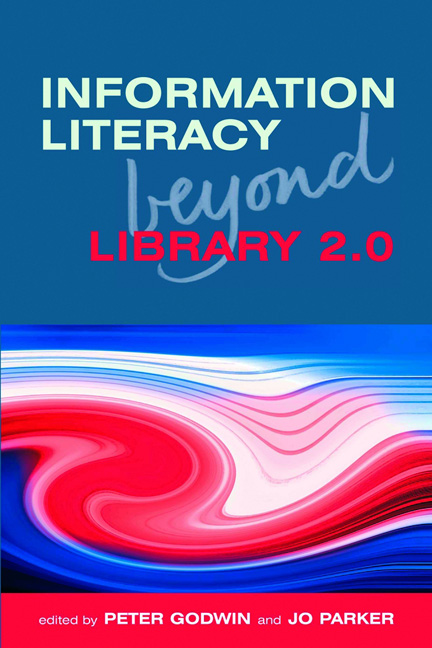Book contents
- Frontmatter
- Contents
- Contributors
- Acknowledgements
- Introduction
- PART 1 RECENT DEVELOPMENTS IN INFORMATION LITERACY AND LIBRARY 2.0
- 1 Library 2.0: a retrospective
- 2 Information literacy and Library 2.0: an update
- 3 The story so far: progress in Web 2.0 and information literacy
- 4 The changing web: sites to social
- 5 Web 2.0: from information literacy to transliteracy
- 6 Informed learning in online environments: supporting the higher education curriculum beyond Web 2.0
- PART 2 CASE STUDIES
- PART 3 WHAT IT MEANS FOR INFORMATION PROFESSIONALS
- Index
2 - Information literacy and Library 2.0: an update
from PART 1 - RECENT DEVELOPMENTS IN INFORMATION LITERACY AND LIBRARY 2.0
Published online by Cambridge University Press: 09 June 2018
- Frontmatter
- Contents
- Contributors
- Acknowledgements
- Introduction
- PART 1 RECENT DEVELOPMENTS IN INFORMATION LITERACY AND LIBRARY 2.0
- 1 Library 2.0: a retrospective
- 2 Information literacy and Library 2.0: an update
- 3 The story so far: progress in Web 2.0 and information literacy
- 4 The changing web: sites to social
- 5 Web 2.0: from information literacy to transliteracy
- 6 Informed learning in online environments: supporting the higher education curriculum beyond Web 2.0
- PART 2 CASE STUDIES
- PART 3 WHAT IT MEANS FOR INFORMATION PROFESSIONALS
- Index
Summary
We could easily have coined the phrase ‘Information Literacy 2.0’ when we wrote our first book. There was very little usage of this term at that time, but we have no regrets. To use such a label then would have threatened hours of creating a definition, satisfying no one! Since then, Špiranec and Zorica (2010) have interpreted Information Literacy 2.0 as a subset of information literacy (IL), and we shall return to this later. It was an exciting time, and I believe it was useful then to concentrate more on how the tools could be used to deliver IL. We could, however, have spent more time considering the effects it would have on what it meant to be information literate. That is the aim of this chapter!
What is IL?
In the past the seemingly endless debates about what information literacy is and whether it is a good label have been a huge bore. It is so easy to say that we must define something before we can do anything about it. Most practising librarians who are involved with educating their users just get on with it and don't agonize over the niceties. It concerns me that much of the research in IL never really permeates down to practitioners, not least because of the portentous language used in the name of scholarship to make it appear appropriately impressive. How many paradigm shifts have you read about? Should I be concerned about the ontological and epistemological positions of my praxis?! Julien and Williamson (2010) are similarly concerned about the disconnect between researchers and practitioners, but for rather different reasons. They are concerned that researchers criticize the IL standards approach but, with some exceptions, are not replacing it with anything based on sufficient observed behaviour.
When necessary, we have to provide IL documentation for institutional learning and teaching plans or reviews, and these tend to refer to generally recognized frameworks like the Big Six or SCONUL Seven Pillars. This can be extremely useful to aid discussion and understanding among colleagues from outside the library. The danger is that they become the blueprint for our IL initiatives day by day. Such frameworks too easily become a series of tick-boxes for skills development. Markless (2009) questioned whether we should ‘continue to present students with generic IL frameworks, models and processes’: IL has always been more complex than this.
- Type
- Chapter
- Information
- Information Literacy Beyond Library 2.0 , pp. 19 - 26Publisher: FacetPrint publication year: 2012
- 1
- Cited by

